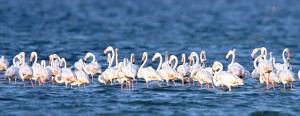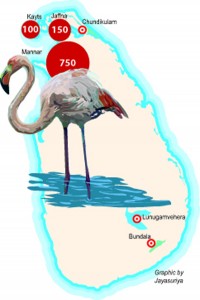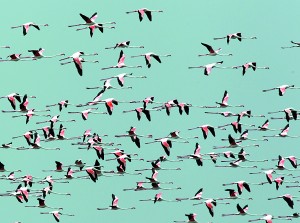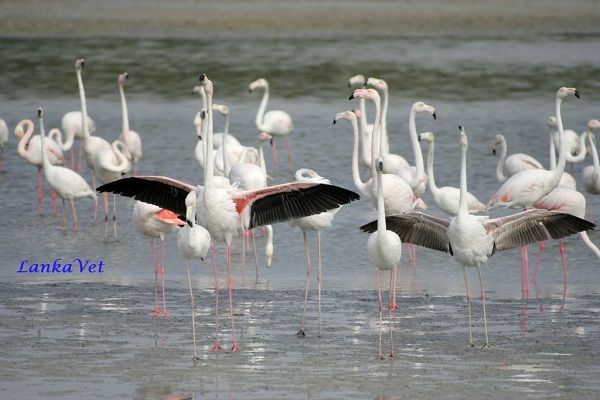
Greater Flamingos in Kayts and in flight in Mannar. Pix by Kithsiri Gunawardena
Slowly and surely the migratory Flamingos are flocking to
north Sri Lanka, although they are shunning the south.
There are about 750 Greater Flamingos in Mannar, about 150
in Jaffna and about 100 on Kayts island this season, says the Joint Secretary
of the Ceylon Bird Club, Kithsiri Gunawardena, who has made many a trip up
north recently.
Although not swelling to the 5,000-6,000 Flamingos recorded
in 2003-04, he is happy that the numbers which dropped to about 200 in Mannar
between 2007 and 2009 are now on the increase.
The south of Sri Lanka particularly Bundala which used to
be colorfully adorned by the beauty of 1,500-2,000 Greater Flamingos, however,
remains bare with the current migratory season which started in September 2012
seeing only a mere four or five, says Mr. Gunawardena.
Going into the intricacies of the sensitivity of the
eco-system, in which the balance may be tilted by even mild changes, this avid
bird-watcher explains that seven to eight years ago Bundala saw large flocks of
Greater Flamingos as the lure was the tiny insect-larvae they preyed on. These
larvae thrived in the brackish water-bodies of Bundala but when fresh water got
mixed with the brackish water due to the Lunugamvehera project, the salinity
dropped and the insect-larvae were not able to survive.
 No food meant there would be no Greater Flamingos, is the
obvious conclusion, and if only environmental experts were called in to minimize
the effects, Sri Lanka’s south would still attract these beautiful birds, it is
understood.
No food meant there would be no Greater Flamingos, is the
obvious conclusion, and if only environmental experts were called in to minimize
the effects, Sri Lanka’s south would still attract these beautiful birds, it is
understood.
Lamenting that Flamingos which make their way from the Rann
of Kutch in Pakistan where they breed and then migrate south during the winter,
have one less habitat now with the loss of Bundala, he urges the protection of
what is left – Mannar, Jaffna and Chundikulam.
It is a lesson on the exotic birds, both migrant and
resident, that Mr. Gunawardena gives when the Sunday Times asks about
speculation that the migrants have not come in their usual numbers to Sri Lanka
this season.
Sri Lanka has 453 species of birds of which 237 species are
resident birds which means that they breed here. The balance 216 bird species
are migrants among whom 72 species are considered “vagrants” coming on and off
unlike the others which are regulars. Sri Lanka which is at the tip of India
shares 89% of all bird species with India but 11% of the resident birds here
are endemic.
This has come about due to different climates and
elevations within our tiny country, says Mr. Gunawardena, adding that “it is
unique”. The endemism is due to montane and low-land forests.
Referring to speculation that migrant-bird numbers have
dropped, he points out that climate change and the recent floods which have
inundated large tracts of land have scattered the ducks and waders. It will
only be the Water Fowl Census which is carried out in February that would
indicate whether the numbers have dropped or there are fluctuations.
 Climate change, according to him, which has far-reaching effects,
has also had an impact on the migratory patterns. Usually, the migrant-season
in Sri Lanka is from end-September 2012 to end-March 2013, but the severe
winter in the Arctic had brought in its wake, the migrants here as early as
March 2012.
Climate change, according to him, which has far-reaching effects,
has also had an impact on the migratory patterns. Usually, the migrant-season
in Sri Lanka is from end-September 2012 to end-March 2013, but the severe
winter in the Arctic had brought in its wake, the migrants here as early as
March 2012.
Unfortunately, March to August is when the resident-birds
breed, but due to the migrants coming in early, the residents have had to face
food issues. Some of the waders which arrived in June-July instead of
September-October are Black-tailed Godwits and Whimbrels.
Getting back to the statistics, Mr. Gunawardena points out that
of the 237 resident species, 33 species are endemic and for 90% of these the
only home is the low-land forests mainly Sinharaja, Samanala kanda and
Knuckles.
This is why there needs to be stringent protection. It is
vital to safeguard this endemism by prevention of encroachment into their
habitat.
The same solution is relevant with regard to migrants – the
challenge is to preserve the pristine environment that flagship species such as
Flamingos and rare birds such as the Pintail, the Wigeon, the Shovellers and
even the Common Teal have made their second home for six months of the year.

Ecology is such a sensitive thing and many factors are
inter-connected, he says, comparing it to a car. If one or two nuts and bolts
are removed, the car may run for a short while but would ultimately stall and
come to a standstill.
There are only a few spots in the world like Viduthalthiv,
between Pooneryn and Mannar where we can see as many as a million birds at the
same time, he says, adding that it is our bounden duty to protect such spots.
“This is our green-gold,” says Mr. Gunawardena. This is
what draws the tourists. It’s not only birds – where else can you see the
biggest mammal in the world, the blue whale off Mirissa and some miles away,
the biggest land animal, the elephant, at Yala.
No comments:
Post a Comment